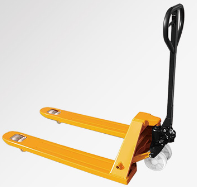News Details
Guidelines for Safe Operation of Manual Hydraulic Trucks in Timber Factories
In the workshop of the lumber mill, the busy figures of workers shuttle through it. And manual hydraulic transport vehicles, like diligent assistants, play an indispensable role in material handling work.
The workshop of a wood factory is often filled with the unique aroma of wood, as huge logs are cut into various specifications of boards and neatly stacked. In such an environment, manual hydraulic transport vehicles have to carry heavy wood every day and run back and forth in narrow passages. Although it may seem simple, consisting only of the body, hydraulic system, and handling fork, it shoulders the responsibility of ensuring efficient transportation of materials.
The safe operation of manual hydraulic handling vehicles is crucial. Firstly, before use, the operator must conduct a comprehensive inspection of the handling vehicle. Check if the vehicle body is damaged, if the handling fork is deformed, and if the hydraulic system is leaking oil. Just like soldiers need to check their weapons and equipment before going to the battlefield, only by ensuring that the transport vehicle is in good condition can it be put into work. For example, if slight deformation is found in the handling fork, it should be repaired or replaced in a timely manner. Otherwise, when handling heavy objects, it is highly likely to break due to the inability to withstand pressure, causing the wood to fall and causing serious accidents.

When preparing to transport materials, it is important to place the wood properly. Place the wood steadily on the fork and ensure that the center of gravity is centered. Imagine if the wood is placed diagonally, just like a person carrying a load with an unstable center of gravity, it is prone to tipping over during walking. After placement, slowly lift the transport fork and closely monitor the working condition of the hydraulic system for any abnormal sounds. If you hear an abnormal "sizzling" sound, it is likely that there is a malfunction in the hydraulic system, and the operation should be stopped immediately for troubleshooting.
During the transportation process, the operator should remain focused and keep their eyes fixed on the front at all times. There are frequent personnel exchanges and various mechanical equipment in the workshop, and collisions may occur if not careful. Moreover, the speed of the transport vehicle should not be too fast, especially at turns, and it is necessary to slow down. It's like driving a car on a bend and slowing down. If the speed is too fast, the transport vehicle is prone to losing balance and overturning on the ground.
After arriving at the destination, it is also important to slowly and steadily lower the transport fork. Accurately place the wood in the designated location to avoid secondary handling or damage to the wood due to improper placement. After completing the handling task, the manual hydraulic handling vehicle should be parked in the designated area and undergo daily maintenance to prepare for the next use.
On the busy stage of the lumber factory, although manual hydraulic transport vehicles may be small, their role is enormous. Only when every operator strictly abides by the safety operating procedures can it operate safely and efficiently, safeguard the production work of the wood factory, ensure the smooth progress of material handling in the workshop, and keep the production rhythm of the wood factory orderly and continuous.

